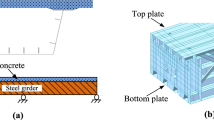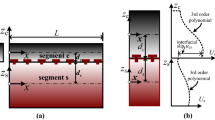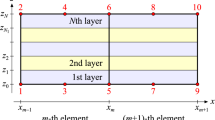Abstract
This paper presents a new mixed finite element model for material and geometric non-linear analysis of composite beams in partial interaction taking into account the non-penetration condition between layers. The Hu–Washizu functional with three independent fields is chosen for the developed mixed formulation. The force fields in the connection are chosen as the redundant forces and approximated using interpolation functions. The remaining force fields are obtained from solving equilibrium equations so that the element equlibrium is verified. Nevertheless, the compatibility as well as the constitutive law is satisfied only in a weak sense. The geometric non-linearity is taken into account by adopting the co-rotational approach. In this paper, the contact condition is imposed at the element level. Augmented Lagrangian method with Uzawa iteration algorithm is used to solve the contact problem. It has been shown that the proposed mixed formulation gives a more accurate result with less elements comparing to classical displacement based model. Besides, the buckling behaviour of delaminated two-layered composite columns has been studied by using the developed mixed formulation model. It has been observed that the buckling strength of the composite column can be overestimated if the uplift is not considered in the model.











Similar content being viewed by others
References
Newmark NM, Siess CP, Viest IM et al (1951) Tests and analysis of composite beams with incomplete interaction. Proc Soc Exp Stress Anal 9(1):75–92
Girhammar U, Gopu V (1993) Composite beam-columns with interlayer slip-exact analysis. J. Struct. Eng. 119(4):1265–1282
Wu Y-F, Oehlers DJ, Griffith MC (2002) Partial-interaction analysis of composite beam/column members. Mech Struct Mach 30(3):309–332
Faella C, Martinelli E, Nigro E (2002) Steel and concrete composite beams with flexible shear connection: exact analytical expression of the stiffness matrix and applications. Comput Struct 80(11):1001–1009
Ranzi G, Bradford MA, Uy B (2004) A direct stiffness analysis of a composite beam with partial interaction. Int J Numer Meth Eng 61(5):657–672
Girhammar UA, Pan DH (2007) Exact static analysis of partially composite beams and beam-columns. Int J Mech Sci 49(2):239–255
Xu R, Wu Y (2007) Static, dynamic, and buckling analysis of partial interaction composite members using Timoshenko’s beam theory. Int J Mech Sci 49(10):1139–1155
Schnabl S, Saje M, Turk G, Planinc I (2007) Analytical solution of two-layer beam taking into account interlayer slip and shear deformation. J Struct Eng 133(6):886–894
Nguyen Q-H, Martinelli E, Hjiaj M (2011) Derivation of the exact stiffness matrix for a two-layer Timoshenko beam element with partial interaction. Eng Struct 33(2):298–307
Nguyen Q-H, Hjiaj M, Guezouli S (2011) Exact finite element model for shear-deformable two-layer beams with discrete shear connection. Finite Elem Anal Des 47(7):718–727
Keo P, Nguyen Q-H, Somja H, Hjiaj M (2016) Derivation of the exact stiffness matrix of shear-deformable multi-layered beam element in partial interaction. Finite Elem Anal Des 112:40–49
Adekola AO (1968) Partial interaction between elastically connected elements of a composite beam. Int J Solids Struct 4(11):1125–1135
Robinson H, Narain KS (1988) Slip and uplift effects in composite beams. In: International conference on composite construction in steel and concrete. Proceedings of an engineering foundation conference ASCE, Amer Society of Civil Engineers, pp 487–497
Dall’Asta A, Zona A (2002) Non-linear analysis of composite beams by a displacement approach. Comput Struct 80(27):2217–2228
Dall’Asta A, Zona A (2004) Slip locking in finite elements for composite beams with deformable shear connection. Finite Elem Anal Design 40(13–14):1907–1930
Ranzi G, Zona A (2007) A steel-concrete composite beam model with partial interaction including the shear deformability of the steel component. Eng Struct 29(11):3026–3041
Zona A, Ranzi G (2011) Finite element models for nonlinear analysis of steel-concrete composite beams with partial interaction in combined bending and shear. Finite Elem Anal Des 47(2):98–118
Martinelli E, Nguyen Q-H, Hjiaj M (2012) Dimensionless formulation and comparative study of analytical models for composite beams in partial interaction. J Constr Steel Res 75:21–31
Battini J-M, Nguyen Q-H, Hjiaj M (2009) Non-linear finite element analysis of composite beams with interlayer slips. Comput Struct 87(13–14):904–912
Ranzi G, Dall’Asta A, Ragni L, Zona A (2010) A geometric nonlinear model for composite beams with partial interaction. Eng Struct 32(5):1384–1396
Hjiaj M, Battini J-M, Nguyen Q-H (2012) Large displacement analysis of shear deformable composite beams with interlayer slips. Int J Non-Linear Mech 47(8):895–904
Keo P, Nguyen Q-H, Somja H, Hjiaj M (2015) Geometrically nonlinear analysis of hybrid beam-column with several encased steel profiles in partial interaction. Eng Struct 100:66–78
Kroflič A, Planinc I, Saje M, Turk G, Čas B (2010) Non-linear analysis of two-layer timber beams considering interlayer slip and uplift. Eng Struct 32(6):1617–1630
Gara F, Ranzi G, Leoni G (2006) Displacement-based formulations for composite beams with longitudinal slip and vertical uplift. Int J Numer Meth Eng 65(8):1197–1220
Kroflič A, Saje M, Planinc I (2011) Non-linear analysis of two-layer beams with interlayer slip and uplift. Comput Struct 89(23–24):2414–2424
Schnabl S, Planinc I (2013) Exact buckling loads of two-layer composite Reissner’s columns with interlayer slip and uplift. Int J Solids Struct 50(1):30–37
Guezouli S, Alhasawi A (2014) A new concept for the contact at the interface of steel-concrete composite beams. Finite Elem Anal Design 87:32–42
Oeng T, Keo P, Guezouli S, Hjiaj M (2023) Large displacement analysis of two-layer beam-columns taking into account slip and uplift. Eng Comput 40(1):265–295
Salari MR, Spacone E, Shing PB, Frangopol DM (1998) Nonlinear analysis of composite beams with deformable shear connectors. J Struct Eng 124(10):1148–1158
Ayoub A (2005) A force-based model for composite steel-concrete beams with partial interaction. J Constr Steel Res 61(3):387–414
Ayoub A, Filippou FC (2000) Mixed formulation of nonlinear steel-concrete composite beam element. J Struct Eng 126(3):371–381
Ferreira M, Andrade A, Providência P, Cabrera F (2018) An efficient three-field mixed finite element model for the linear analysis of composite beams with deformable shear connection. Compos Struct 191:190–201
Magisano D, Corrado A (2023) New robust and efficient global iterations for large deformation finite element analysis of beams and shells with material nonlinearity. Comput Methods Appl Mech Eng 406:115900
Schnabl S, Saje M, Turk G, Planinc I (2007) Locking-free two-layer Timoshenko beam element with interlayer slip. Finite Elem Anal Des 43(9):705–714
Nguyen Q-H, Hjiaj M, Lai V-A (2014) Force-based FE for large displacement inelastic analysis of two-layer Timoshenko beams with interlayer slips. Finite Elem Anal Des 85:1–10
Erkmen RE, Bradford MA (2011) Treatment of slip locking for displacement-based finite element analysis of composite beam-columns. Int J Numer Methods Eng 85(7):805–826
Gara F, Ranzi G, Leoni G (2006) Displacement-based formulations for composite beams with longitudinal slip and vertical uplift. Int J Numer Methods Eng 65(8):1197–1220
Wriggers P, Laursen TA (2006) Computational contact mechanics, vol 2. Springer, Berlin
Leonetti L, Liguori FS, Magisano D, Kiendl J, Reali A, Garcea G (2020) A robust penalty coupling of non-matching isogeometric Kirchhoff–Love shell patches in large deformations. Comput Methods Appl Mech Eng 371:113289
Fraeijs De Veubeke B, Zienkiewicz OC (2001) Displacement and equilibrium models in the finite element method. Int J Numer Meth Eng 52(3):287–342
Ansourian P (1982) Experiments on continuous composite beams. Proc Inst Civ Eng 73(1):26–51
Johnson RP, Anderson D (2004) Designers’ guide to EN 1994-1-1: eurocode 4: design of composite steel and concrete structures. General rules and rules for buildings. Thomas Telford, Wolverhampton
ACI318. Building code requirements for structural concrete (ACI 318-08) and commentary. 2008
Kent DC, Park R (1971) Flexural members with confined concrete. J Struct Div 97(7):1969–1990
Ollgaard JG, Slutter RG, Fisher JW (1971) Shear strength of stud connectors in lightweight and normal weight concrete, aisc eng’g jr., april 1971 (71–10). AISC Engineering Journal, pp 55–34
Author information
Authors and Affiliations
Contributions
The authors PK and TO contributed to writing the original draft of the paper, coding and performing the analysis. MH provided the guidance and review of the paper.
Corresponding author
Ethics declarations
Conflict of interest
The authors declare that they have no Conflict of interest of any nature.
Additional information
Publisher's Note
Springer Nature remains neutral with regard to jurisdictional claims in published maps and institutional affiliations.
Rights and permissions
Springer Nature or its licensor (e.g. a society or other partner) holds exclusive rights to this article under a publishing agreement with the author(s) or other rightsholder(s); author self-archiving of the accepted manuscript version of this article is solely governed by the terms of such publishing agreement and applicable law.
About this article
Cite this article
Keo, P., Oeng, T. & Hjiaj, M. Mixed-formulation with non-penetration constraint for planar composite beams in partial interaction. Comput Mech (2024). https://doi.org/10.1007/s00466-024-02476-2
Received:
Accepted:
Published:
DOI: https://doi.org/10.1007/s00466-024-02476-2




